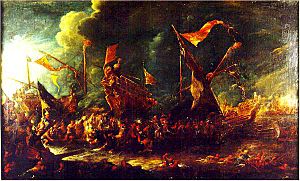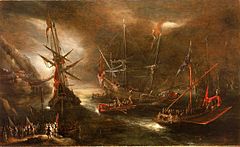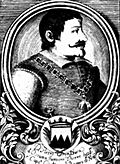Battle of Cape Corvo facts for kids
Quick facts for kids Battle of Cape Corvo |
|||||||
|---|---|---|---|---|---|---|---|
| Part of the Ottoman-Habsburg wars | |||||||
 Battle between Spanish and Ottoman galleys. Oil on canvas attributed to Cornelis de Wael. |
|||||||
|
|||||||
| Belligerents | |||||||
| Commanders and leaders | |||||||
| Ottavio d'Aragona | Sinari Pasha (POW) | ||||||
| Strength | |||||||
| 8 galleys | 10 galleys | ||||||
| Casualties and losses | |||||||
| 6 killed, 30 wounded |
7 galleys captured, 400 killed, 600 prisoners, 1,200 slaves freed |
||||||
The Battle of Cape Corvo was an important sea fight during the Ottoman–Habsburg wars. These wars were a long struggle for control of the Mediterranean Sea. This battle happened in August 1613 near the island of Samos. A Spanish fleet from Sicily, led by Admiral Ottavio d'Aragona, fought against an Ottoman fleet led by Sinari Pasha.
The Spanish won this battle. They captured seven Ottoman ships called galleys and took about 600 prisoners. Among the prisoners were important Ottoman leaders, including the Bey of Alexandria. The Battle of Cape Corvo was the first big victory for the Spanish fleets under Pedro Téllez-Girón, 3rd Duke of Osuna. He was the Spanish ruler, or Viceroy of Sicily, at the time. It was also the biggest Spanish victory over the Ottoman Empire since the famous Battle of Lepanto.
Contents
When Pedro Téllez-Girón, the 3rd Duke of Osuna, became the Viceroy of Sicily in 1610, he had a big goal. After stopping crime on the island, he wanted to rebuild Sicily's navy. When he arrived, the Spanish fleet in Sicily had no ships ready for battle. People were afraid of an Ottoman attack.
By July 1612, Osuna had managed to build eight galleys and several other sailing ships. Galleys were long, oar-powered ships often used in the Mediterranean. The sailing ships were used for carrying supplies. Osuna put his favorite naval commander, Ottavio d'Aragona from Palermo, in charge of this small fleet.
D'Aragona led some attacks on Ottoman lands. He surprised places like La Goulette and Cherchell. In the same year, another Spanish commander, Don Antonio Pimentel, burned seven sailing ships in the port of Tunis. These ships were led by an English renegade, someone who had switched sides.
Osuna's biggest victory in 1612 was stopping a large Ottoman fleet. This fleet tried to capture Messina in August. The Spanish captured two galleys and three smaller ships called galliots. They also got back a ship that the Ottomans had taken from Cartagena. Any Ottoman soldiers who landed on shore were cut off from their ships. They either gave up to the Spanish cavalry or tried to run away inland.
Preparing for Battle
In mid-1613, d'Aragona led 200 musketeers (soldiers with muskets), 50 arquebusiers (soldiers with arquebuses), and 100 pikemen (soldiers with long spears) to Chicheri. There, they attacked and destroyed an Ottoman castle. More than 800 Turks died in this fight.
When d'Aragona returned, Osuna told him to get ready for a big fight. He wanted d'Aragona to challenge the Ottoman fleet in their own waters. The Viceroy had heard that a large Ottoman fleet was leaving Constantinople. Even though his spies didn't say the Ottomans were planning to attack Sicily, Osuna wanted to be sure.
D'Aragona's galleys were made stronger. Each galley got 100 muskets, 50 spontoons (short spears), 20 bucklers (small shields), and 150 chuzos (another type of spear). These extra weapons were for the rowers, so they could help the soldiers fight if needed. Osuna's main ship, called the flagship, was made even stronger. It had 160 musketeers and seven cannons.
According to Osuna's spies, the Ottoman fleet had 12 galleys. They were led by Mahomet Pasha, who was a lieutenant of Nasauf Pasha. Nasauf Pasha stayed in Constantinople to talk with Sultan Ahmed I about the war with Persia.
The Battle at Cape Corvo

Ottavio d'Aragona sailed his eight galleys into the Aegean Sea. South of Samos, some Greek fishermen told the Spanish Admiral that 10 Ottoman galleys were nearby. These ships were led by Sinari Pasha.
With the help of a skilled Greek guide, the Spanish squadron sailed through the Mycale Strait. They arrived off Cape Corvo, where the Ottoman fleet was anchored. The Ottoman ships were arranged in a battle line: two galleys in front, two in the middle, and three at the back. D'Aragona had already been warned about Sinari Pasha's ships by a small boat called a felucca that he had sent ahead.
D'Aragona ordered his fleet to attack. His squadron followed him as he approached the Ottoman ships. He rammed his flagship right into the Ottoman flagship. After three hours of intense fighting, Sinari Pasha surrendered his galley. His second-in-command and five other galleys also surrendered. The remaining three Ottoman galleys managed to escape.
About 400 Ottoman soldiers and sailors were killed in the battle. Another 600 were captured. Among the most important prisoners were Sinari Pasha himself, who sadly died soon after, and Mahamet. Mahamet was the Bey of Alexandria and the son of Müezzinzade Ali Pasha, who had commanded the Ottoman fleet at the famous Battle of Lepanto. A great outcome of the battle was that 1,200 Christian galley slaves were set free.
The Spanish had very few losses. Only six men were killed and 30 were wounded. The Spanish fleet soon returned to Sicily with their seven captured ships. These ships were added to the Spanish fleet when they arrived at Messina. During their journey back, they captured another small ship called a brigantine with 17 Turks on board.
The entire fleet almost sank in a storm near Cape Solanto, which was about 10 leagues from Messina. But with the help of about 70 barges (flat-bottomed boats), all the ships managed to enter the port safely.
What Happened Next
On September 27, Osuna held a big celebration in Palermo to honor Ottavio d'Aragona. The Spanish Viceroy, d'Aragona, Cardinal Doria, the captains and knights of the galleys, the freed slaves, the 600 Ottoman prisoners, and the 900 soldiers who fought in the battle all marched through the city streets. Osuna's special flag, called a pennon, and the captured Ottoman flags led the parade.
The Sicilian navy continued to grow stronger in the years that followed. It achieved even more important victories at the battles of Cape Celidonia and Ragusa. These later victories were led by Francisco de Rivera y Medina, who was one of Spain's most skilled naval commanders at that time.
Images for kids
-
Spanish Men-of-War Engaging Barbary Pirates, painting of 1615 by Cornelis Vroom.
See also
 In Spanish: Batalla del cabo Corvo para niños
In Spanish: Batalla del cabo Corvo para niños







